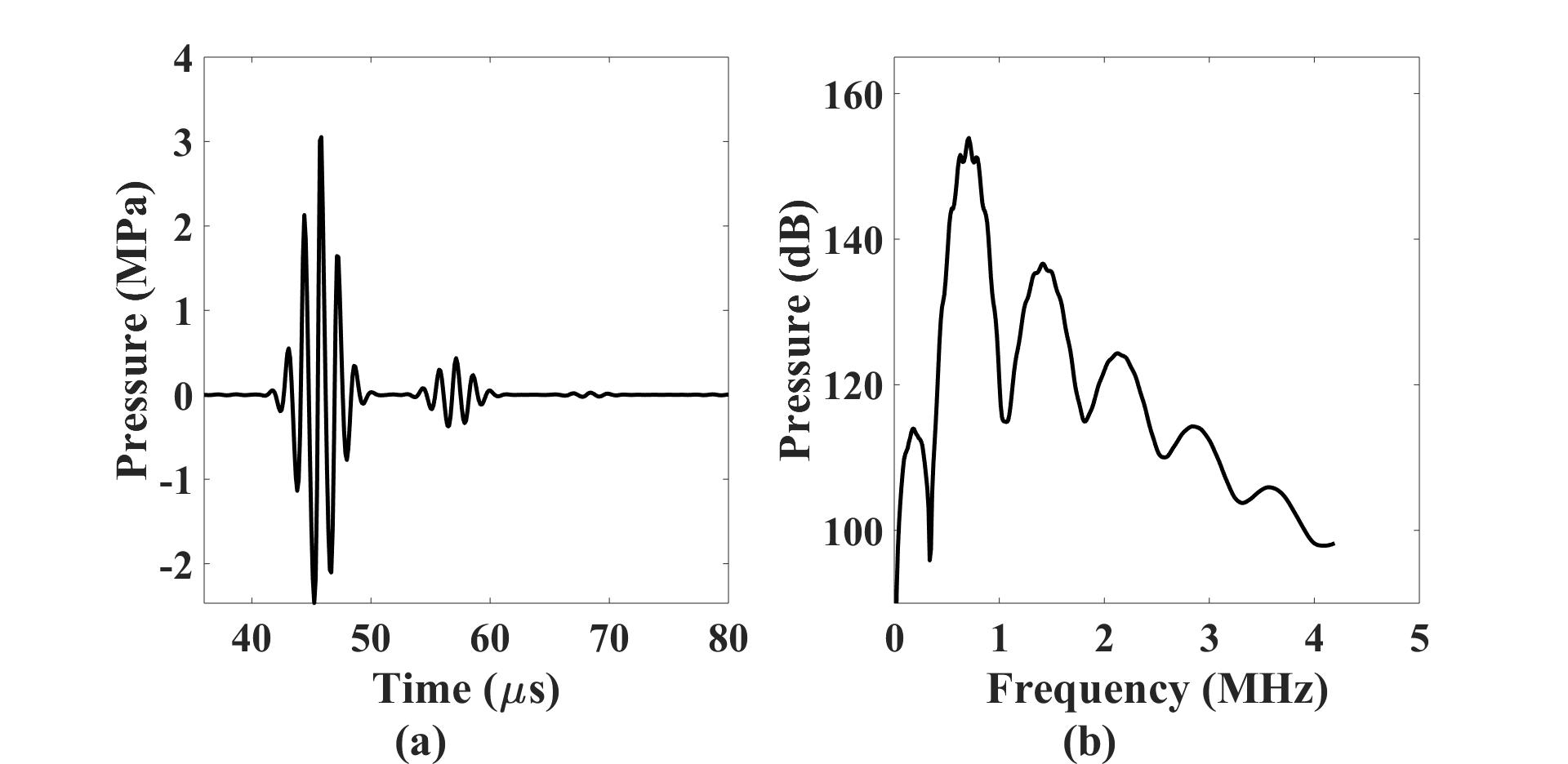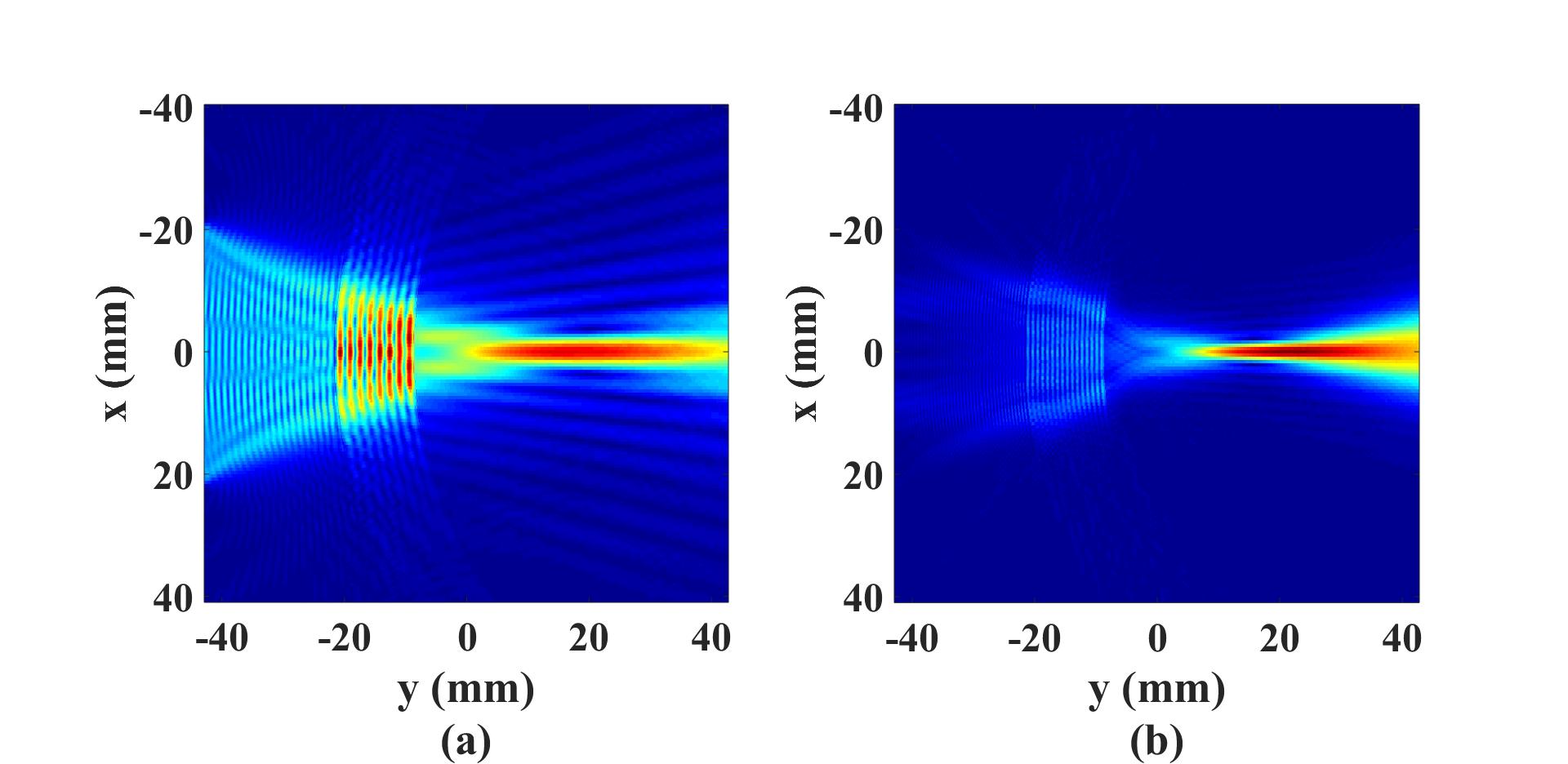Simulation of a strongly 2D heterogeneous medium using the transient mixed domain method
This example demonstrates how to use the transient mixed domain method (TMDM) for simulating wave propagation in 2D, strongly heterogeneous media. For strongly heterogeneous media (e.g., skulls), phase and amplitude corrections are needed as the original mixed domain method only applies to weakly heterogeneous media (in terms of speed of sound and density variations). This example shows how to apply these corrections. Generally, for simulations of heterogeneous media with small speed of sound or density contrast (contrast ratio being less than 1.05), it is unnecessary to apply corrections.
Generating the grid structure to define the computational domain
We first need to define the temporal and spatial computational domains in 2D forward simulations
with the funciton set_grid. For 2D problems, six inputs
are required to call this function. Coordinates defined within the
mgrid structure are all in the Cartesian coordinates.
The spatial resolution should in principle be a small fraction of the wavelength (e.g., 1/4 of the wavelength).
The temporal resolution should at least satisfy the Nyquist criteria.
dx = 5.3571e-04; % step size in the x direction [m]
dy = 1.3393e-04; % step size in the y direction [m]
dt = 1.1905e-07; % time step size [s]
x_length = 0.1671; % computational domain size in x direction [m]
y_length = 0.0857; % computational domain size in y direction [m]
t_length = 6.8571e-05; % temporal domain size [s]
mgrid = set_grid(dt, t_length, dx, x_length, dy, y_length);
Defining the medium properties
The transducer setting in this case is similar to the example
Simulation of a
2D homogeneous medium using the transient mixed domain method.
In this example, the speed of sound contrast and density contrast are all 1.5.
The 2D model used in this example is shown in the figure below.
p0 = 1.0e6; % source pressure magnitude [Pa]
fc = 0.7e6; % fundamental frequency [Hz]
TR_focus = 0.0643; % transducer focal length [m]
TR_radius = 0.0214; % Transducer radius [m]
load 2D_strongly_heterogeneous_model.mat % load the tissue model data
medium.c = c; % speed of sound [m/s]
medium.rho = rho; % density [kg/m^3]
medium.beta = beta; % nonlinearity coefficient
medium.ca = ca; % attenuation coefficient [dB/(MHz^y cm)]
medium.cb = cb; % power law exponent

2D forward simulation
The acoustic pressure field is calculated with the function Forward2D. Corrections are applied in this example because of the strong speed of sound and density contrast. Reflections up to the fourth-order are also included in this simulation.
% define where the pressure will be recorded
sensor_mask = zeros(mgrid.num_x, mgrid.num_y+1);
sensor_mask(100:300, 2:end) = 1;
% the maximum order of reflection included in the simulation
reflection_order = 4;
% 2D forward simulation
p_total = Forward2D(mgrid, medium, source_p, sensor_mask,...
reflection_correction, 'correction');
The figure below shows the (a) waveform and (b) frequency-domain spectrum for the signal recorded at the transducer focal
point.
 The figure below shows the acoustic pressure field (a) at the fundamental and (b) at the second-harmonic frequency.
The figure below shows the acoustic pressure field (a) at the fundamental and (b) at the second-harmonic frequency.

Other examples
·
Simulation of a 2D homogeneous medium using the transient mixed domain method
·
Simulation of a 2D heterogeneous medium using the transient mixed domain method
·
Simulation of a strongly 2D heterogeneous medium using the transient mixed domain method
·
Simulation of a 3D homogeneous medium using the transient mixed domain method
·
Selecting the proper temporal domain size for the TMDM
·
Shock wave simulations with TMDM
·
Simulation of a 2D homogeneous medium using the frequency-specific mixed domain method
·
Simulation of a 2D heterogeneous medium using the frequency-specific mixed domain method
·
Simulation of a 3D homogeneous medium using the frequency-specific mixed domain method
·
Simulation of a 3D heterogeneous medium using the frequency-specific mixed domain method
·
Reducing the spatial aliasing error using the non-reflecting layer
·
Comparing pressure release and rigid boundary conditions
·
Image reconstruction using backward projection
·
Reconstruction of the source pressure distribution with FSMDM in a 3D homogeneous medium
·
Integrating mSOUND with k-Wave for transducers of arbitrary shape
·
Integrating mSOUND with FOCUS for transducers of arbitrary shape
·
Integrating mSOUND with k-Wave for thermal simulations
